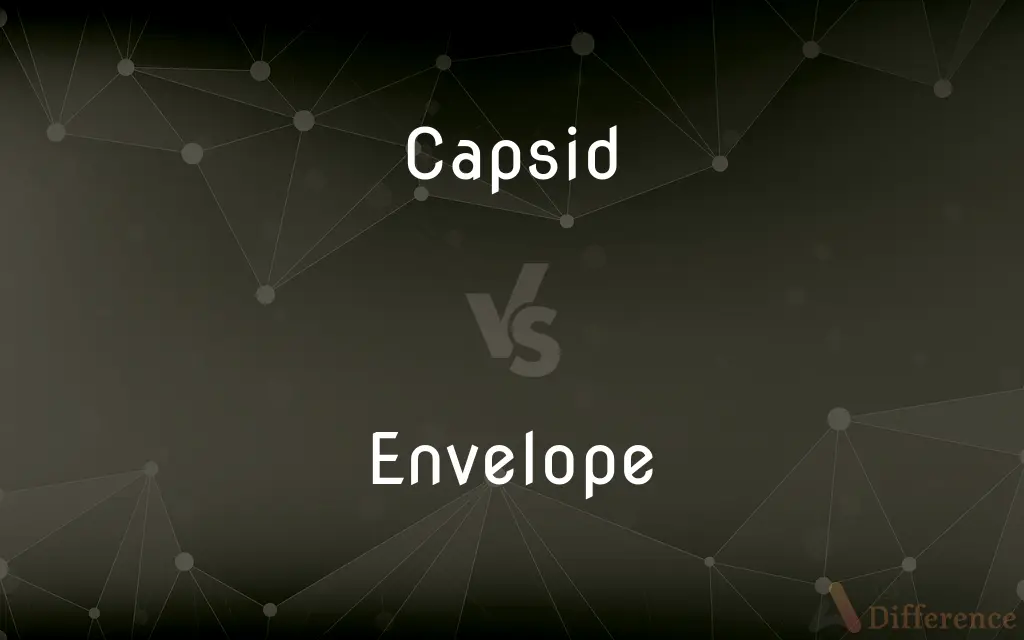Capsid vs. Envelope — What's the Difference?

Difference Between Capsid and Envelope
ADVERTISEMENT
Compare with Definitions
Capsid
A capsid is the protein shell of a virus, enclosing its genetic material. It consists of several oligomeric (repeating) structural subunits made of protein called protomers.
Envelope
An envelope is a common packaging item, usually made of thin, flat material. It is designed to contain a flat object, such as a letter or card.
Capsid
The protein coat that constitutes the shell of a virus particle.
Envelope
A flat paper container with a sealable flap, used to enclose a letter or document.
Capsid
The outer protein shell of a virus
ADVERTISEMENT
Envelope
A covering or containing structure or layer
The external envelope of the swimming pool
Capsid
A variety of leaf bug
Envelope
A flat paper container, especially for a letter, usually having a gummed flap.
Capsid
The outer covering of protein surrounding the nucleic acid of a virus
Envelope
Something that envelops; a wrapping.
Envelope
(Biology) An enclosing structure or cover, such as a membrane or the outer coat of a virus.
Envelope
The bag containing the gas in a balloon or airship.
Envelope
The set of limitations within which a technological system, especially an aircraft, can perform safely and effectively.
Envelope
A usually spherical region of interstellar matter surrounding a forming star and interacting with the star's gravitational and radiation fields.
Envelope
The coma of a comet.
Envelope
(Mathematics) A curve or surface that is tangent to every one of a family of curves or surfaces.
Envelope
A paper or cardboard wrapper used to enclose small, flat items, especially letters, for mailing.
Envelope
Something that envelops; a wrapping.
Envelope
A bag containing the lifting gas of a balloon or airship; fabric that encloses the gas-bags of an airship.
Envelope
(geometry) A mathematical curve, surface, or higher-dimensional object that is the tangent to a given family of lines, curves, surfaces, or higher-dimensional objects. Category:en:Curves
Envelope
(electronics) A curve that bounds another curve or set of curves, as the modulation envelope of an amplitude-modulated carrier wave in electronics.
Envelope
(music) The shape of a sound, which may be controlled by a synthesizer or sampler.
Envelope
(computing) The information used for routing a message that is transmitted with the message but not part of its contents.
Envelope
(biology) An enclosing structure or cover, such as a membrane; a space between two membranes
Envelope
(engineering) The set of limitations within which a technological system can perform safely and effectively.
Envelope
(astronomy) The nebulous covering of the head or nucleus of a comet; a coma.
Envelope
An earthwork in the form of a single parapet or a small rampart, sometimes raised in the ditch and sometimes beyond it.
Envelope
Archaic form of envelop
Envelope
That which envelops, wraps up, encases, or surrounds; a wrapper; an inclosing cover; esp., the cover or wrapper of a document, as of a letter.
Envelope
The nebulous covering of the head or nucleus of a comet; - called also coma.
Envelope
A work of earth, in the form of a single parapet or of a small rampart. It is sometimes raised in the ditch and sometimes beyond it.
Envelope
A curve or surface which is tangent to each member of a system of curves or surfaces, the form and position of the members of the system being allowed to vary according to some continuous law. Thus, any curve is the envelope of its tangents.
Envelope
A set of limits for the performance capabilities of some type of machine, originally used to refer to aircraft; - it is often described graphically as a two-dimensional graph of a function showing the maximum of one performance variable as a function of another. Now it is also used metaphorically to refer to capabilities of any system in general, including human organizations, esp. in the phrase push the envelope. It is used to refer to the maximum performance available at the current state of the technology, and therefore refers to a class of machines in general, not a specific machine.
Envelope
A flat rectangular paper container for papers
Envelope
Any wrapper or covering
Envelope
A curve that is tangent to each of a family of curves
Envelope
A natural covering (as by a fluid);
The spacecraft detected an envelope of gas around the comet
Envelope
The maximum operating capability of a system;
Test pilots try to push the envelope
Envelope
The bag containing the gas in a balloon
Share Your Discovery

Previous Comparison
Stink vs. Sting
Next Comparison
Brush vs. Bush















































